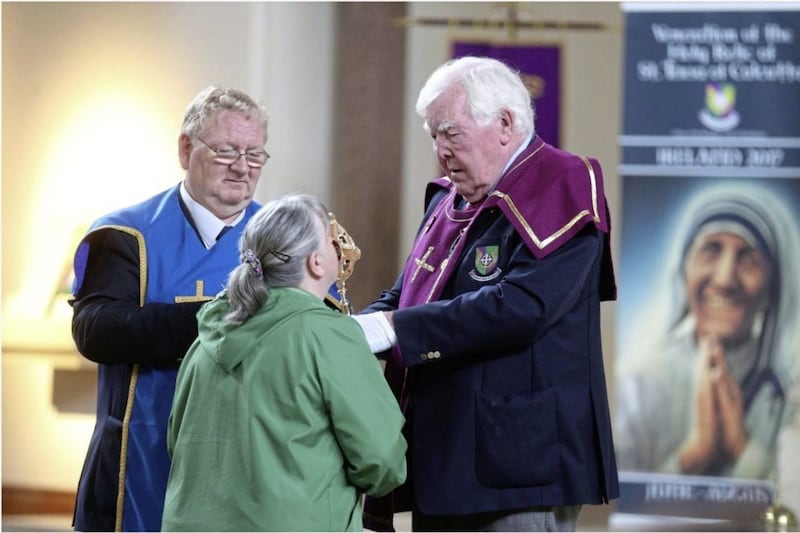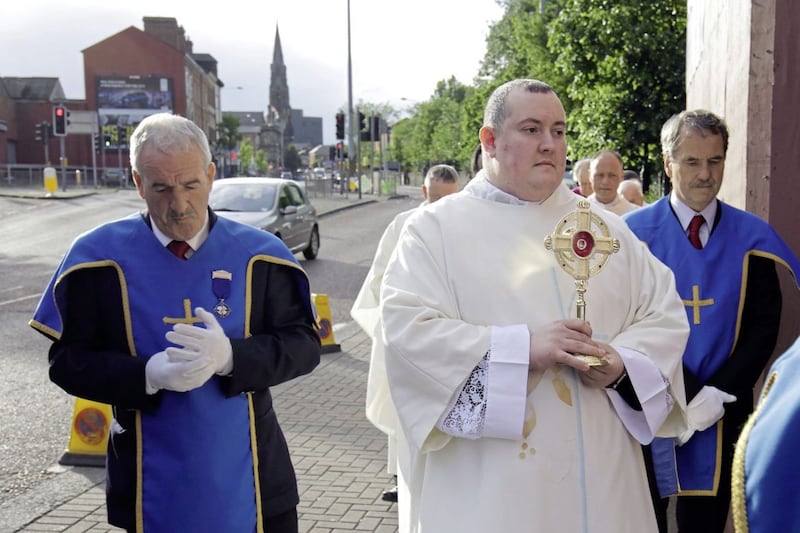UNTIL 1969, Mother Teresa was a nun working anonymously in the shadows of Calcutta. Then Malcolm Muggeridge, the famous English journalist, on a visit to India, heard a rumour of some women physically carrying the dying from the streets, picking abandoned babies out of bins, giving homes to the poor and, with a journalist's instinct for a story, asked to meet them.
Their leader was Mother Teresa.
Something about her compelled him. He made a film about her and then wrote a book about the experience. Both were called, 'Something Beautiful for God'.
What attracted him compelled the attention of the world. The rest is history.
Had that film not been made or the book published, it is likely that the rest of her life would have been lived quietly in the shadows and we would ever have heard her name. But she would still have been a saint - an anonymous saint.
Because what is a saint but someone who allows God to use their life to bring beauty to his world - someone whose life does something beautiful for God? It's about the best description that I have found.
Mother Teresa was arguably the most influential woman of the last decades of the 20th century - how many hundreds of thousands of people are alive because of what she did? How many millions inspired to turn their hearts towards the poor because of her voice?
What was Mother Teresa but someone whose life unfolded for the world a vision of the beauty of God's love for the poor? And to think that St Teresa walked the streets of our city.
Last week in St Patrick's we welcomed her relics to Belfast as they are brought around Ireland. We venerate them, and we praise God that he can work miracles through simple, human beings such as she.
What is a saint but someone who allows God to use their life to bring beauty to his world - someone whose life does something beautiful for God?"
We Catholic Christians - and not just Catholics, but the Orthodox and Anglicans - venerate saints because they show us what we can be at our best.
'Saint' is simply the official title given to someone by the Church whose life has been investigated and found to be such that, when dead, they are judged to be in that intimate closeness to God we call 'heaven'.
We are inclined to think of saints as exceptions to the norm but 'saint' need not mean exceptional.
A saint is at heart someone who was fascinated by the life and person of Jesus Christ; who lived as if he were guiding them now on their journey through the earth; and who tried to model their lives on his Way, the Beatitudes.
And of all the few thousand people - like St Teresa of Calcutta - who have the official title 'saint', there are literally millions more who are saints but whose lives were anonymous.
There are people now living - living in this city - who lead just such lives. I suspect they wouldn't recognise themselves.
But we do more than simply honour the memory of a holy woman: we venerate her relics.
Those younger than I may know nothing about relics. Those older may think that the very mention of relics is itself a relic of the past.
An occasion such as this is a good time to remind ourselves of the teaching of the Church.
Let's be clear what a relic is: it is a piece, usually bone or blood, of a saint's body. Sometimes the word relic means a piece of a saint's clothing.
It can be more: if you go to Drogheda, in St Peter's Church, you can find the head of St Oliver Plunkett inside a glass and gold case.
Many of you will have been there; or touched the glove worn by St Pio of Pietrelcina, stained with the blood of the hand he used to bless people. Each, relics.
Let's be clear what relics are not: they are not magic trinkets. They contain no power in themselves.
We Catholic Christians often make use of images, statues, medals, relics and other objects for this reason: to call to mind our relationships with the saints of the past; and our living relationship with the God who inspired them and whom we are trying to follow.
Why pieces of bone and blood? What are they for? Well, right back at the start, the earliest Christians showed honour to the departed saints by respecting their remains.
In the catacombs in Rome, the buried them in stone tombs and then built altars over these tombs.
In fact, embedded into every altar today, 2,000 years later, are small fragments of saints' bones.
It's about remembering. It's about respect. It's about connecting with the God who made us temples of the Holy Spirit and became one of us. It's about solidarity. It's about reminding us of what we can be at our best.
There is another spiritual reason for the early Christians' treatment of the relics of the saint. Frequently, miracles were reported by those who came into contact with these remains.
In the Gospel of Mark, people were healed simply by touching Jesus outer garment. In the Acts of the Apostles, healings are reported to have occurred when people touched handkerchiefs to St Paul's body and then brought them to the sick.
Similar miracles have been worked when relics of the saints have been brought to the sick. The Catholic belief in relics is deeply Biblical.
God uses all sorts of material things to testify to the spiritual power released through the life of an exceptionally holy man or woman.
Why should that surprise us? Why shouldn't he use things? He uses bread and wine to bring his presence to us in Holy Communion.
St Teresa of Calcutta once said: "I am simply God's little pencil. He writes with me." What a beautiful, simple, humble, inspiring phrase. It could apply equally to all of us.
The question for us, as we honour St Teresa of Calcutta, as we contemplate this saint of mercy, as we venerate her relics, is: do we want to be like her? Do we wish to be saints?

If so, all we have to do is to want God to write his words with our lives. As with all saints, at some stage in her life, St Teresa of Calcutta began to sense the mystery behind all things; she began to believe in Jesus; she took his life and words to heart; she lived her life with him as her model; she hoped to meet him at the end of her journey. She saw his presence especially in those who had least, who were least.
Her message is clear. Let's not accept the tawdry values of this world - where worth is defined by glamour or wealth.
Let's not keep our eyes limited to this world. Let's not let our life and our hopes and our dreams be just about this world.
Let's sense the mystery transcending this world, because our hearts were made for that. God wants us to be saints now, so that at the end of our journey we can be saints in that ultimate closeness to him, in heaven. And that is possible.
Like St Teresa of Calcutta, we can become fascinated by the life and person of Jesus; we can meet him in the Gospels, in the liturgy and in prayer. We can live our life with him as a guide now. We can model our lives on his way - the Beatitudes - or try to, every day. In our own way, we can serve the least, the poorest, the weakest.
And if we do, God will write with us. Then our simple efforts - even done quietly in the shadows - will transform this earth.
And, at the end of our journey through it, we will be welcomed by St Teresa of Calcutta and all the saints, into the reward of paradise for which our time on earth is only the dry run, because, with these lives, we will have done something beautiful for God.
- Fr Eugene O'Neill is Adminstrator of St Patrick's, Donegall Street in Belfast. A relic of St Teresa of Calcutta was in the church last week and, courtesy of the Knights of St Columbanus, is on a journey around Ireland before being received at its permanent home in Newry Cathedral on August 11. A full itinerary can be seen here.









